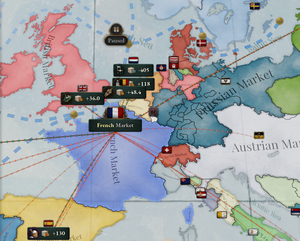无编辑摘要 |
无编辑摘要 |
||
| 第1行: | 第1行: | ||
{{Version|pre-release}} | {{Version|pre-release}} | ||
[[File:Map market overview.png|thumb|A bird's eye view of the French market.]] | [[File:Map market overview.png|thumb|A bird's eye view of the French market.|链接=Special:FilePath/Map_market_overview.png]] | ||
在维多利亚3中,一个单位的商品被生产出来后立即以当时由有意购买的消费者的数量决定的价格出售。当这种情况发生时,价格就会随着实际的供求关系而发生变化,市场之间的贸易是用销售和购买订单来模拟的,这使经济模型能更有效地反映突然的经济变化。系统中的任何储备都表现为现金(例如建筑物的现金储备或国家的[[treasury|国库]] )或人群的财富,这构成了生活水平的基础,并决定了他们的消费水平。 | |||
== | == 国家市场 == | ||
国家市场是游戏内动态经济的推手,它根据全世界每个地区的所有贸易商品的供求关系来决定合理的价格。扩大国家市场以拥有更多的领土意味着为国家的熔炉提供更多的原材料,为其制造业提供更多的客户。随着玩家的工业基础的增长,其国家对基础设施的需求也在增长,以便将货物推向市场。 | |||
默认情况下,每个国家都控制着自己的市场,该市场通常(但不总是)以其首都为中心。每个通过陆路或由港口连接的海路与这个市场中心相连的地区也是市场的一部分。这些地区都有不同程度的[[market access|市场接入度]] ,代表了它们与市场上其他地区的联系程度。 | |||
各地区的所有本地消费和生产都对市场的购买和销售订单做出了贡献。这类似于商品市场上的订单——例如,更高的粮食消费将导致贸易商提交更多的粮食购买订单,而更高的丝绸产量将导致更多的丝绸销售订单。 | |||
=== | === 共同市场 === | ||
外交玩法。多个国家可以加入到同一个市场。有时这是由更强大的国家领导的'' 关税同盟条约'' 的结果,但更多时候是因为与傀儡国或半独立殖民地的附属国关系。在某些情况下,国家甚至可以在别人的市场内拥有一小块土地,例如'' 条约港'' 。扩大一国经济实力的途径不仅包括增加国内生产和消费,还可以通过外交和/ 或军事手段。 | |||
== | == 市场价格 == | ||
所有商品都有一个基本价格。这是在理想的市场条件下的价格(即购买订单的数量等于销售订单的数量)。例如,如果建筑物的生产量超过了需求量,那么每单位的产品都将以较低的价格出售。这对消费者有利,对生产者不利。同样,如果需求高于供给,每单位产品将以更高的价格出售。这给生产建筑带来了更多的收入,而增加了人群和依赖这些商品继续经营的建筑的花费。 | |||
市场价格基于市场购买和销售订单之间的平衡,以基准价格为基准。买单比卖单越多,价格就会越高,反之亦然。提交给市场的买卖订单根据各地区拥有的市场接入度来衡量。这意味着基础设施欠发达的地区将减少与市场的交易,而更多地依赖当地可用的商品。 | |||
拥有完全市场接入度的地区将对所有商品采用市场价格。否则,只能使用市场价格的一部分,当地价格的其他部分则由商品的当地消费和生产组成。所有实际交易均以当地价格进行,市场价格则根据市场接入度成比例地减少当地的失衡。 | |||
市场上商品的价格由以下公式给出: | |||
<math> | <math> 价格 = BASE\_PRICE * \left(1+0.75 *\frac{BUY-SELL}{\min(BUY,SELL)}\right) | ||
</math> | </math> | ||
例如,对于基准价格为 20 的小麦来说,当有 100 个购买订单和 120 个销售订单时,它的价格将是: | |||
<math>price = 20 * \left(1+0.75 *\frac{100-120}{\min(100,120)}\right)=20*(1-0.15)=17 | <math>price = 20 * \left(1+0.75 *\frac{100-120}{\min(100,120)}\right)=20*(1-0.15)=17 | ||
</math> | </math> | ||
或者说比基本价格低 15% ,因为供大于求。 | |||
公式可以通过某些参数来改变, | |||
<math>PRICE\_RANGE</math> 和 <math>BUY\_SELL\_DIFF\_AT\_MAX\_FACTOR</math> 的值在游戏中被定义为0.75和2,这将把公式扩展为 | |||
<math> 价格 = BASE\_PRICE * \left(1+\frac{PRICE\_RANGE}{BUY\_SELL\_DIFF\_AT\_MAX\_FACTOR-1}*\frac{BUY-SELL}{\min(BUY,SELL)}\right) | |||
<math> | |||
</math> | </math> | ||
价格限制在 <math>1+PRICE\_RANGE</math> 和 <math>1-PRICE\_RANGE</math> 之间。 | |||
== | == 供给过剩和供给不足 == | ||
如果供给过剩变得足够大,销售价格将如此之低,以至于生产者将无法维持工资来保持产量,除非他们获得政府补贴。 | |||
另一方面,商品短缺会给市场上依赖它的人带来可怕的影响;例如,依赖它作为投入品的建筑物的生产效率会急剧下降。短缺需要立即采取行动,无论是加快国内生产,从其他市场进口,还是扩大市场来包括该商品的主要生产商。如果所有其他方法都失败了,从建筑物中消除对上述商品的需求(通过更改为旧的生产方式)可能会使建筑物恢复到边际盈利能力。 | |||
=== 短缺 === | === 短缺 === | ||
当市场上某商品的购买订单数量是销售订单数量的两倍多时,该商品将出现 [[File:Goods shortage.png|24px|链接=Special:FilePath/Goods_shortage.png]] 短缺。这由商品图标旁边的短缺图标 [[File:Goods shortage.png|24px|链接=Special:FilePath/Goods_shortage.png]] 表示。短缺将减少市场内所有需要该商品作为投入品的建筑物的吞吐量。该修正将以每天 1% 的速度缓慢增长,最高可达 75% 。短缺解决后,修正不会立即消失,而是会开始以相同的每天 1% 下降,直到达到 0 并移除修正。 | |||
这种影响极具破坏性,因为已经以极高的价格(+75% )购买其中一种投入品的建筑物现在也将获得吞吐量损失。然而,这个问题会随时间自行解决,因为随着建筑物的吞吐量下降,对商品的需求就会减少,并且随着建筑物变得不那么有利可图,工人可能会转移到其他行业。这两种效果都会减少对短缺商品的需求并缓慢缓解短缺,但是在一定比例的短缺效果下可能会出现平衡,仍然降低建筑物的效率,因此仍然需要玩家来解决这个问题。 | |||
== References == | == References == | ||
2022年11月14日 (一) 18:38的版本
在维多利亚3中,一个单位的商品被生产出来后立即以当时由有意购买的消费者的数量决定的价格出售。当这种情况发生时,价格就会随着实际的供求关系而发生变化,市场之间的贸易是用销售和购买订单来模拟的,这使经济模型能更有效地反映突然的经济变化。系统中的任何储备都表现为现金(例如建筑物的现金储备或国家的国库)或人群的财富,这构成了生活水平的基础,并决定了他们的消费水平。
国家市场
国家市场是游戏内动态经济的推手,它根据全世界每个地区的所有贸易商品的供求关系来决定合理的价格。扩大国家市场以拥有更多的领土意味着为国家的熔炉提供更多的原材料,为其制造业提供更多的客户。随着玩家的工业基础的增长,其国家对基础设施的需求也在增长,以便将货物推向市场。
默认情况下,每个国家都控制着自己的市场,该市场通常(但不总是)以其首都为中心。每个通过陆路或由港口连接的海路与这个市场中心相连的地区也是市场的一部分。这些地区都有不同程度的市场接入度,代表了它们与市场上其他地区的联系程度。
各地区的所有本地消费和生产都对市场的购买和销售订单做出了贡献。这类似于商品市场上的订单——例如,更高的粮食消费将导致贸易商提交更多的粮食购买订单,而更高的丝绸产量将导致更多的丝绸销售订单。
共同市场
外交玩法。多个国家可以加入到同一个市场。有时这是由更强大的国家领导的关税同盟条约的结果,但更多时候是因为与傀儡国或半独立殖民地的附属国关系。在某些情况下,国家甚至可以在别人的市场内拥有一小块土地,例如条约港。扩大一国经济实力的途径不仅包括增加国内生产和消费,还可以通过外交和/或军事手段。
市场价格
所有商品都有一个基本价格。这是在理想的市场条件下的价格(即购买订单的数量等于销售订单的数量)。例如,如果建筑物的生产量超过了需求量,那么每单位的产品都将以较低的价格出售。这对消费者有利,对生产者不利。同样,如果需求高于供给,每单位产品将以更高的价格出售。这给生产建筑带来了更多的收入,而增加了人群和依赖这些商品继续经营的建筑的花费。
市场价格基于市场购买和销售订单之间的平衡,以基准价格为基准。买单比卖单越多,价格就会越高,反之亦然。提交给市场的买卖订单根据各地区拥有的市场接入度来衡量。这意味着基础设施欠发达的地区将减少与市场的交易,而更多地依赖当地可用的商品。
拥有完全市场接入度的地区将对所有商品采用市场价格。否则,只能使用市场价格的一部分,当地价格的其他部分则由商品的当地消费和生产组成。所有实际交易均以当地价格进行,市场价格则根据市场接入度成比例地减少当地的失衡。
市场上商品的价格由以下公式给出:
[math]\displaystyle{ 价格 = BASE\_PRICE * \left(1+0.75 *\frac{BUY-SELL}{\min(BUY,SELL)}\right) }[/math]
例如,对于基准价格为 20的小麦来说,当有 100 个购买订单和 120 个销售订单时,它的价格将是:
[math]\displaystyle{ price = 20 * \left(1+0.75 *\frac{100-120}{\min(100,120)}\right)=20*(1-0.15)=17 }[/math]
或者说比基本价格低 15%,因为供大于求。
公式可以通过某些参数来改变,
[math]\displaystyle{ PRICE\_RANGE }[/math] 和 [math]\displaystyle{ BUY\_SELL\_DIFF\_AT\_MAX\_FACTOR }[/math] 的值在游戏中被定义为0.75和2,这将把公式扩展为
[math]\displaystyle{ 价格 = BASE\_PRICE * \left(1+\frac{PRICE\_RANGE}{BUY\_SELL\_DIFF\_AT\_MAX\_FACTOR-1}*\frac{BUY-SELL}{\min(BUY,SELL)}\right) }[/math]
价格限制在 [math]\displaystyle{ 1+PRICE\_RANGE }[/math] 和 [math]\displaystyle{ 1-PRICE\_RANGE }[/math]之间。
供给过剩和供给不足
如果供给过剩变得足够大,销售价格将如此之低,以至于生产者将无法维持工资来保持产量,除非他们获得政府补贴。
另一方面,商品短缺会给市场上依赖它的人带来可怕的影响;例如,依赖它作为投入品的建筑物的生产效率会急剧下降。短缺需要立即采取行动,无论是加快国内生产,从其他市场进口,还是扩大市场来包括该商品的主要生产商。如果所有其他方法都失败了,从建筑物中消除对上述商品的需求(通过更改为旧的生产方式)可能会使建筑物恢复到边际盈利能力。
短缺
当市场上某商品的购买订单数量是销售订单数量的两倍多时,该商品将出现 ![]() 短缺。这由商品图标旁边的短缺图标
短缺。这由商品图标旁边的短缺图标 ![]() 表示。短缺将减少市场内所有需要该商品作为投入品的建筑物的吞吐量。该修正将以每天 1% 的速度缓慢增长,最高可达 75%。短缺解决后,修正不会立即消失,而是会开始以相同的每天 1% 下降,直到达到 0 并移除修正。
表示。短缺将减少市场内所有需要该商品作为投入品的建筑物的吞吐量。该修正将以每天 1% 的速度缓慢增长,最高可达 75%。短缺解决后,修正不会立即消失,而是会开始以相同的每天 1% 下降,直到达到 0 并移除修正。
这种影响极具破坏性,因为已经以极高的价格(+75%)购买其中一种投入品的建筑物现在也将获得吞吐量损失。然而,这个问题会随时间自行解决,因为随着建筑物的吞吐量下降,对商品的需求就会减少,并且随着建筑物变得不那么有利可图,工人可能会转移到其他行业。这两种效果都会减少对短缺商品的需求并缓慢缓解短缺,但是在一定比例的短缺效果下可能会出现平衡,仍然降低建筑物的效率,因此仍然需要玩家来解决这个问题。
